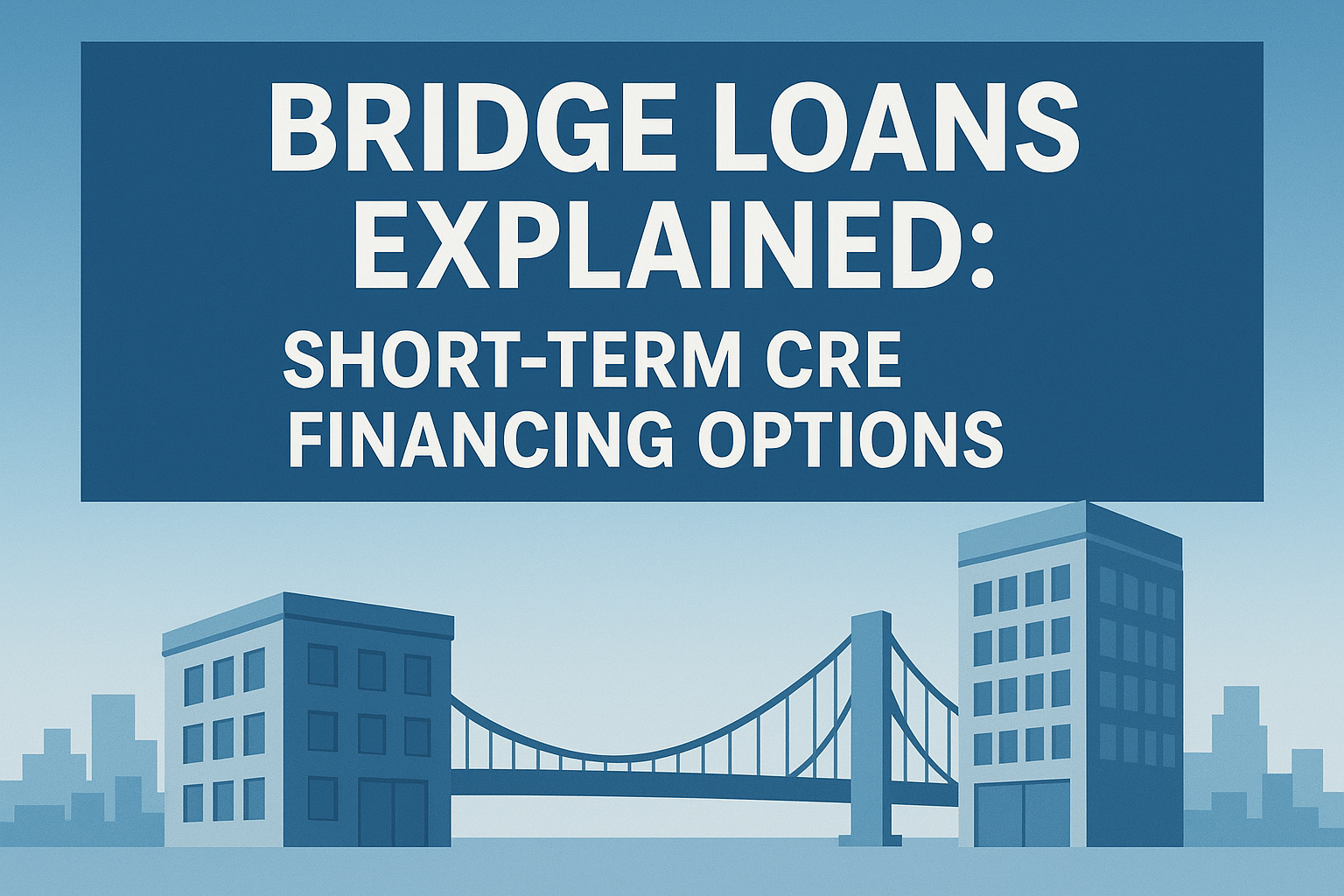What Is a Bridge Loan for Commercial Property? A bridge loan for commercial property is short-term financing that helps real estate investors, developers, or business owners “bridge the gap” between an immediate funding need and permanent financing.
In plain terms, it’s temporary capital used to buy, renovate, or stabilize a property before securing a long-term CRE loan, SBA loan, or refinance.
You’ll often see bridge loans used when borrowers need to:
Buy a property quickly before another loan closes
Fund renovations or stabilization work
Free up equity in a property being sold
Cover financing gaps while waiting for SBA or bank approval
These loans are especially common for transitional or value-add properties—assets that need improvements before conventional lenders will finance them.
Example:
A developer buys an office complex using a 12-month bridge loan, renovates it to raise occupancy, and then refinances into a 20-year SBA 504 loan once the property stabilizes.
How Bridge Loans Work
A bridge loan functions like a financial bridge, connecting today’s property need with tomorrow’s permanent financing.
Typical Flow:
Key traits:
Term: 6–36 months
Payments: Often interest-only
Collateral: The property itself
Exit strategy: Sale or refinance into a permanent loan
Because bridge loans close quickly and carry more risk, they come with higher interest rates and fees than standard CRE loans—but the tradeoff is speed and flexibility.
Typical Bridge Loan Terms & Rates
| Factor | Typical Range | Notes |
|---|---|---|
| Loan Size | $250K–$50M+ | Based on property value |
| Term | 6–36 months | Short-term, often interest-only |
| Rates | 8%–12% | Depends on borrower profile & exit plan |
| LTV | 65%–80% | Lower LTV = better rate |
| Fees | 1%–3% | Origination and closing costs |
💡 Pro Tip: Lenders reward borrowers with strong exit plans. Clearly show how you’ll repay or refinance (sale, SBA loan, or permanent CRE loan), and you’ll likely secure a lower rate.
When to Use a Commercial Bridge Loan
Bridge financing is best suited for time-sensitive, transitional, or value-add property situations such as:
Buying property before selling another
Waiting for SBA or conventional loan approval
Renovating or repositioning an asset
Releasing trapped equity to fund new deals
Managing short-term cash-flow gaps
🚀 Compare bridge loan offers from top lenders.
Bridge Loan vs. Permanent Commercial Loan
| Feature | Bridge Loan | Permanent CRE Loan |
|---|---|---|
| Term | 6–36 months | 5–25 years |
| Rates | 8%–12% | 5%–10% |
| Repayment | Interest-only | Principal + interest |
| Speed | 1–3 weeks | 1–3 months |
| Purpose | Transitional or short-term funding | Long-term ownership or refinance |
| Best For | Value-add projects, quick acquisitions | Stabilized income properties |
Bridge loans deliver speed and flexibility, while permanent loans focus on stability and lower cost.
Pros & Cons of Bridge Loans
✅ Advantages
Fast approval and funding (sometimes in 1–2 weeks)
Flexible underwriting standards
Interest-only payments improve cash flow
Perfect for time-sensitive acquisitions or transitions
❌ Drawbacks
Higher rates and fees
Short maturity period
Requires a solid exit plan
Not ideal for weak-credit borrowers
Top Bridge Loan Lenders
| Lender | Best For | Approx. Rate | Loan Range | Highlights |
|---|---|---|---|---|
| Lima One Capital | Fix-and-flip, construction, bridge | 8.45%–10.2% | $250K–$10M+ | Quick funding, flexible underwriting |
| Kiavi | Investors/rental portfolios | 6.75% – 9.45% | $100K–$3M | Fast digital approval, DSCR-based lending |
| RCN Capital | Experienced investors | 8%–12% | $250K–$10M | Short-term bridge expertise |
| Lendio | Marketplace comparison | 5%–14% | $50K–$5M+ | One form → 75+ lender offers |
How to Qualify for a Commercial Bridge Loan
Most lenders will evaluate your loan request based on:
Collateral: The property’s current or after-repair value
Equity: 20–35% down payment or existing equity
Credit Score: 640+ recommended
Exit Strategy: Defined refinance or sale timeline
Example:
A developer secures a $1M bridge loan at 9% for 12 months to renovate a warehouse. After upgrades, the property’s value rises, and the borrower refinances into a long-term SBA 504 loan.
Application Process
Submit the loan request and property details
Receive a preliminary term sheet
The lender orders an appraisal and reviews the DSCR & exit plan
Underwriting and final approval
Close and fund—often within 1–3 weeks
Bridge Loan Alternatives
If a bridge loan doesn’t fit your budget or timeline, consider these alternatives:
SBA 504 / 7(a) loans—Lower rates, but slower funding
Hard money loans—even faster approvals, higher costs
Conventional CRE loans—stable, long-term financing
Mezzanine or private debt—best for large or complex projects
FAQs About Commercial Bridge Loans
How long does it take to get approved?
Usually 1–3 weeks; some private or hard money lenders can fund in just a few days.
Can I use one for construction?
Yes—many bridge lenders offer construction draws, especially when the exit strategy is well-documented.
What’s the biggest risk?
Failing to refinance or sell before the loan matures. A clear, realistic exit plan is critical.
Are bridge loans only for investors?
No. Many owner-occupied businesses use bridge loans to purchase or upgrade facilities before permanent financing closes.
Final Take—Is a Bridge Loan Right for You?
A bridge loan is ideal when speed matters more than cost. If you have equity, a strong exit plan, and a time-sensitive deal, bridge financing can unlock capital that traditional banks can’t provide fast enough.
Check out the complete guide here: Commercial Real Estate Loans.

